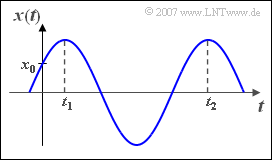Aufgaben:Aufgabe 2.3Z: Schwingungsparameter: Unterschied zwischen den Versionen
Aus LNTwww
| Zeile 42: | Zeile 42: | ||
|type="{}"} | |type="{}"} | ||
$\tau$ = { 2 3% } $\text{ms}$ | $\tau$ = { 2 3% } $\text{ms}$ | ||
| − | $\varphi$ = { | + | $\varphi$ = { 60 3% } $\text{Grad}$ |
| Zeile 52: | Zeile 52: | ||
{Wie lautet das Spektrum $X(f)$? Welches Gewicht hat die Spektrallinie bei $+f_0$? | {Wie lautet das Spektrum $X(f)$? Welches Gewicht hat die Spektrallinie bei $+f_0$? | ||
|type="{}"} | |type="{}"} | ||
| − | $\text{Re}[X(f = f_0)]$ = { 1.5 3% } $\text{V}$ | + | $\text{Re}[X(f = f_0)]$ = { 1.5 3% } $\text{V}$ |
| − | $\text{Im}[X(f = f_0)]$ = | + | $\text{Im}[X(f = f_0)]$ = { -2.65--2.55 } $\text{V}$ |
Version vom 15. Januar 2017, 15:21 Uhr
Jede harmonische Schwingung kann auch in der Form
- $$x(t)=C\cdot\cos\bigg(2\pi \cdot \frac{t-\tau}{T_0}\bigg)$$
geschrieben werden. Die Schwingung ist somit durch drei Parameter vollständig bestimmt:
- die Amplitude $C$,
- die Periodendauer $T_0$,
- die Verschiebung $\tau$ gegenüber einem Cosinussignal.
Eine zweite Darstellungsform lautet mit der Grundfrequenz $f_0$ und der Phase $\varphi$:
- $$x(t)=C \cdot\cos(2\pi f_0t-\varphi).$$
Von einer harmonischen Schwingung ist nun bekannt, dass
- das erste Signalmaximum bei $t_1 = 2 \,\text{ms}$ auftritt,
- das zweite Signalmaximum bei $t_2 = 14 \,\text{ms}$ auftritt,
- der Wert $x_0 = \text{x(t = 0)} = 3 \,\text{V}$ ist.
Hinweise:
- Die Aufgabe gehört zum Kapitel Harmonische Schwingung.
- Sollte die Eingabe des Zahlenwertes „0” erforderlich sein, so geben Sie bitte „0.” ein.
Fragebogen
Musterlösung
1. Es gilt $T_0 = t_2 – t_1 = 12 \text{ms}$ und $f_0 = 1/T_0 \underline{\approx 83.33 \text{Hz}}$.
2. Die Verschiebung beträgt $\tau = 2 \text{ms}$; die Phase ist $\varphi = 2\pi \cdot \tau/T_0 = \pi/3$ entsprechend $60°$.
3. Aus dem Wert zum Zeitpunkt $t = 0$ folgt für die Amplitude $\text{C} = 6 \text{V}$:
- $$x_0=x(t=0)=C\cdot\cos(-60\,^\circ)=\frac{C}{2}=\rm 3\,V \hspace{0.3 cm} \Rightarrow \hspace{0.3 cm}\hspace{0.15cm}\underline{\it C=\rm 6\,V}.$$
4. Die dazugehörige Spektralfunktion lautet:
- $$X(f)=\frac{C}{2}\cdot{\rm e}^{-{\rm j}\varphi}\cdot\delta(f-f_0)+\frac{C}{2}\cdot{\rm e}^{{\rm j}\varphi}\cdot\delta(f+f_0).$$
Das Gewicht der Diraclinie bei $f = f_0$ (erster Term) ist $\text{C}/2 \cdot e^{–\text{j}\varphi} \approx \underline{1.5 \text{V} – \text{j} \cdot 2.6 \text{V}}$.
